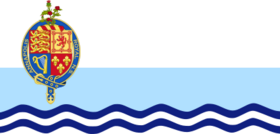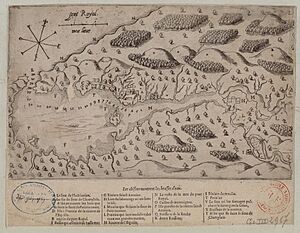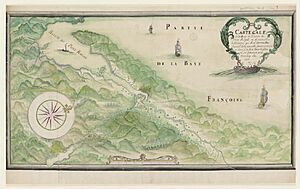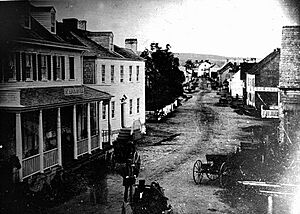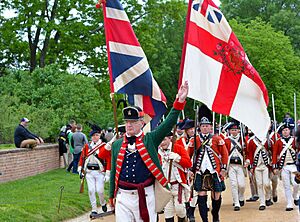Annapolis Royal facts for kids
Quick facts for kids
Annapolis Royal
Port-Royal (French)
|
||
|---|---|---|
|
Town and County seat
|
||
|
Waterfront of Annapolis Royal
View from Fort Anne looking south over Annapolis Basin
Saint Luke's Church
Pierre Dugua Monument
Lighthouse
View of Granville Ferry from Annapolis Royal
|
||
|
||
| Nickname(s):
Cradle of the Nation
|
||
| Country | Canada | |
| Province | Nova Scotia | |
| Municipality | Annapolis County | |
| Founded | 1605 as Port Royal | |
| Incorporated | 1892 | |
| Named for | Anne, Queen of Great Britain | |
| Electoral Districts Federal |
West Nova |
|
| Provincial | Annapolis | |
| Area
(2016)
|
||
| • Total | 2.04 km2 (0.79 sq mi) | |
| Highest elevation | 7 m (23 ft) | |
| Lowest elevation | 0 m (0 ft) | |
| Population
(2021)
|
||
| • Total | 530 | |
| • Density | 268.3/km2 (695/sq mi) | |
| Demonym(s) | Annapolitan | |
| Time zone | UTC-4 (AST) | |
| • Summer (DST) | UTC-3 (Atlantic Daylight Saving Time) | |
| Postal code |
B0S1A0
|
|
| Area code(s) | 902 | |
| Telephone Exchange | 526, 532 | |
| Official name: Annapolis Royal Historic District National Historic Site of Canada | ||
| Designated: | 1994 | |
Annapolis Royal is a small town in Nova Scotia, Canada. It's the main town in Annapolis County. Before 1710, it was known as Port Royal. This community has one of the longest histories in North America, even older than settlements like Plymouth and Jamestown. For almost 150 years, it was the capital of Acadia and then Nova Scotia. This changed when Halifax was founded in 1749.
In 1605, France started a settlement here. Later, in 1629, Scotland took over and built a new settlement. The town changed hands many times between France, Scotland, England, and Great Britain. Finally, in 1713, it became part of Great Britain. Because of its important location, it was attacked 13 times, more than any other place in North America!
In 1994, the historic center of Annapolis Royal was named a National Historic Site of Canada. This means it's a very important place in Canadian history. Today, the town focuses a lot on tourism.
Contents
- What's in a Name?
- A Look Back in Time
- Town Population
- Where is Annapolis Royal?
- What Annapolis Royal Offers
- Historic Places to Visit
- Arts and Fun
- Learning in Town
- Sister Cities
- Famous People from Annapolis Royal
- Named After the Town
- Images for kids
What's in a Name?
The name "Port Royal" was first used by mapmaker Samuel de Champlain in 1604 for the Annapolis Basin. He wrote about entering a large harbor he called Port Royal. The French settlement was renamed "Annapolis Royal" in 1710. This was done to honor Queen Anne after Great Britain took control of the area.
A Look Back in Time
Early Days
The area where Annapolis Royal is now was called Nme'juaqnek by the Mi'kmaq people. This means "the place of bountiful fish." The Mi'kmaq have lived here for thousands of years. Tools found at Fort Anne show people were here 2,000 to 3,000 years ago.
The First Settlements
The first French settlement was built in 1605 by Pierre Dugua, Sieur de Mons and others. It was called the habitation at Port-Royal. This settlement was about 10 kilometers (6 miles) west of today's Annapolis Royal. In 1613, it was destroyed by attackers from Virginia. But it was the first European settlement in Canada where people lived all year round! Apples were also brought to Canada here in 1606.
In 1629, Scottish settlers built their own settlement called Charles Fort. This was at the mouth of the Annapolis River, where the town is now. In 1632, the French took control again. The settlement grew slowly and faced many attacks from English forces. But each time, it was returned to French control.
Becoming Annapolis Royal
In 1710, during Queen Anne's War, the British finally captured Port Royal from the French. This was a big moment, as it marked the British taking over Nova Scotia. The British then named the town Annapolis Royal and the fort Fort Anne after Queen Anne.
Attacks on Annapolis Royal
After the British took over, there were still attempts to get the town back. In 1711, 600 Acadian and Indigenous warriors tried to take Fort Anne. But they didn't have cannons, so they couldn't break through the fort's defenses. Annapolis Royal stayed British.
In 1713, the Treaty of Utrecht officially gave Acadia to Great Britain. However, the exact borders were unclear, leading to more conflicts.
Conflicts and Changes
Blockade and Raids (1722-1724)
During a conflict known as Father Rale's War, Indigenous groups tried to block Annapolis Royal in 1722. They captured fishing boats and people to try and starve the town. The British took some Indigenous people hostage to stop the attacks. In 1724, a group of Mi'kmaq and Maliseets raided Annapolis Royal. They killed soldiers, burned houses, and took prisoners. After this, three blockhouses were built to protect the town.
King George's War (1744-1746)
During King George's War, the French, Acadians, and Mi'kmaq tried four times to recapture Annapolis Royal.
- In July 1744, 300 Mi'kmaq warriors attacked. The fort was saved when British soldiers arrived.
- In September 1744, French officers attacked with 200 men. The siege lasted a week, but British reinforcements arrived, and the French retreated.
- In 1745, another siege happened, but it ended quickly when the French forces were called away to help defend Louisbourg.
- In 1746, French land forces besieged the town for 23 days, waiting for naval support that never came. They had to retreat.
Seven Years' War and Deportation

The Seven Years' War (1756–1763) was a big conflict between France and Great Britain. During this time, many Acadians were forced to leave their homes.
Acadian Deportation (1755)
On December 8, 1755, 32 Acadian families (225 people) were forced onto a British ship called the Pembroke from Annapolis Royal. The ship was headed for North Carolina. However, the Acadians took control of the ship! On February 8, 1756, they sailed up the Saint-John River, burned their ship, and joined other Acadian communities.
American Revolutionary War
During the American Revolutionary War (1775–1783), Nova Scotia mostly stayed loyal to Great Britain. British soldiers were stationed in Annapolis Royal to protect it from American privateers (armed ships). In 1778, British soldiers defeated an American privateer raiding the port.
However, in 1780, the soldiers left, leaving the town unprotected. In 1781, two American privateer ships attacked the town. They locked up the men in the fort and stole from houses. They fled when they heard the local militia was gathering.
Loyalists Arrive
After the American Revolution, over 30,000 United Empire Loyalists moved to Nova Scotia. Many came to Annapolis Royal. These were people who had supported the British during the war. Many Loyalists later moved to nearby towns like Digby. Some, like Jacob Bailey, stayed and became important members of the town.
Many Black Loyalists, who were formerly enslaved people who fought for the British, also came. One important leader was Thomas Peters. Another notable Black Loyalist was Rose Fortune, who started a freight business and helped police the Annapolis Royal waterfront. The Loyalists brought new skills and money, helping the town grow.
19th Century Growth
Annapolis Royal's harbor wasn't very deep, so it didn't have a huge shipping trade. But it was a local center for shipbuilding. The town had a small boom in 1869 when the Windsor and Annapolis Railway arrived. This brought more people and factories. The population reached 1,500 in the 1870s. Annapolis Royal officially became a town in 1893. However, when the railway extended to Digby and Yarmouth, most steamship business moved there. By 1901, the population had shrunk, and Annapolis Royal became a smaller town, mainly known for exporting apples.
Modern Times
A ferry used to connect Annapolis Royal to Granville Ferry across the river. A bridge was built in 1921, but it collapsed in 1961 and was replaced by a causeway.
The Annapolis Royal Generating Station was a special power plant that used the ocean's tides to create electricity. It was the only one of its kind in North America and could produce 20 megawatts of power twice a day. It opened in 1984 but stopped producing power in 2019.
Today, tourism is a big part of the town's economy. Many people visit the historic sites. In 1984, Annapolis Royal made history by electing Daurene Lewis, the first female Black mayor in Canada.
Town Population
| Historical population | ||
|---|---|---|
| Year | Pop. | ±% |
| 1971 | 758 | — |
| 1976 | 738 | −2.6% |
| 1981 | 631 | −14.5% |
| 1986 | 631 | +0.0% |
| 1991 | 633 | +0.3% |
| 1996 | 583 | −7.9% |
| 2001 | 550 | −5.7% |
| 2006 | 444 | −19.3% |
| 2011 | 481 | +8.3% |
| 2016 | 491 | +2.1% |
| 2021 | 530 | +7.9% |
In 2021, Annapolis Royal had a population of 530 people. This was a small increase from its 2016 population of 491. The town covers about 1.98 square kilometers (0.76 square miles).
Where is Annapolis Royal?
Annapolis Royal is located at the western end of the Annapolis Valley. It sits on the south bank of the Annapolis River, facing the Annapolis Basin. The town's waterfront is a key part of its historic charm. Right across the river is the community of Granville Ferry. The Bay of Fundy is about 10 kilometers (6 miles) north of the town.
The Annapolis Basin, Annapolis River, Annapolis County, and the Annapolis Valley are all named after the town.
Weather in Annapolis Royal
Annapolis Royal has a humid continental climate. This means it usually has mild summers and cold winters. It tends to be wet throughout the year.
| Climate data for Annapolis Royal (1981–2010) | |||||||||||||
|---|---|---|---|---|---|---|---|---|---|---|---|---|---|
| Month | Jan | Feb | Mar | Apr | May | Jun | Jul | Aug | Sep | Oct | Nov | Dec | Year |
| Record high °C (°F) | 18.5 (65.3) |
17.5 (63.5) |
21.7 (71.1) |
26.0 (78.8) |
30.0 (86.0) |
34.0 (93.2) |
32.2 (90.0) |
32.8 (91.0) |
30.0 (86.0) |
25.6 (78.1) |
22.2 (72.0) |
19.4 (66.9) |
34.0 (93.2) |
| Mean daily maximum °C (°F) | −0.7 (30.7) |
0.1 (32.2) |
3.4 (38.1) |
9.0 (48.2) |
15.8 (60.4) |
20.4 (68.7) |
23.3 (73.9) |
23.3 (73.9) |
19.0 (66.2) |
13.2 (55.8) |
8.0 (46.4) |
2.1 (35.8) |
11.4 (52.5) |
| Daily mean °C (°F) | −4.3 (24.3) |
−3.8 (25.2) |
−0.3 (31.5) |
5.1 (41.2) |
11.1 (52.0) |
15.5 (59.9) |
18.5 (65.3) |
18.6 (65.5) |
14.9 (58.8) |
9.6 (49.3) |
4.9 (40.8) |
−1.1 (30.0) |
7.4 (45.3) |
| Mean daily minimum °C (°F) | −7.8 (18.0) |
−7.6 (18.3) |
−4.0 (24.8) |
1.2 (34.2) |
6.2 (43.2) |
10.2 (50.4) |
13.3 (55.9) |
13.4 (56.1) |
10.3 (50.5) |
5.9 (42.6) |
1.7 (35.1) |
−4.1 (24.6) |
3.2 (37.8) |
| Record low °C (°F) | −26.0 (−14.8) |
−27.2 (−17.0) |
−24.4 (−11.9) |
−13.3 (8.1) |
−6.1 (21.0) |
−3.3 (26.1) |
−1.1 (30.0) |
0.0 (32.0) |
−2.2 (28.0) |
−8.3 (17.1) |
−13.3 (8.1) |
−23.9 (−11.0) |
−27.2 (−17.0) |
| Average precipitation mm (inches) | 114.4 (4.50) |
85.2 (3.35) |
94.3 (3.71) |
94.7 (3.73) |
86.4 (3.40) |
74.4 (2.93) |
68.7 (2.70) |
68.5 (2.70) |
110.3 (4.34) |
120.4 (4.74) |
125.3 (4.93) |
112.5 (4.43) |
1,155.2 (45.48) |
| Average rainfall mm (inches) | 59.5 (2.34) |
51.6 (2.03) |
67.0 (2.64) |
87.0 (3.43) |
86.0 (3.39) |
74.4 (2.93) |
68.7 (2.70) |
68.5 (2.70) |
110.3 (4.34) |
120.4 (4.74) |
118.0 (4.65) |
80.2 (3.16) |
991.8 (39.05) |
| Average snowfall cm (inches) | 54.9 (21.6) |
33.5 (13.2) |
27.3 (10.7) |
7.7 (3.0) |
0.4 (0.2) |
0.0 (0.0) |
0.0 (0.0) |
0.0 (0.0) |
0.0 (0.0) |
0.0 (0.0) |
7.3 (2.9) |
31.2 (12.3) |
162.4 (63.9) |
| Average precipitation days (≥ 0.2 mm) | 13.7 | 10.9 | 11.3 | 11.3 | 11.0 | 11.1 | 8.6 | 8.3 | 10.2 | 11.2 | 13.2 | 12.9 | 133.5 |
| Average rainy days (≥ 0.2 mm) | 6.1 | 5.5 | 7.6 | 10.4 | 10.9 | 11.1 | 8.6 | 8.3 | 10.2 | 11.2 | 12.4 | 8.5 | 110.7 |
| Average snowy days (≥ 0.2 cm) | 9.2 | 6.4 | 5.0 | 1.7 | 0.05 | 0.0 | 0.0 | 0.0 | 0.0 | 0.0 | 1.4 | 5.2 | 28.9 |
| Source: Environment Canada | |||||||||||||
What Annapolis Royal Offers
Tourism and History
Tourism is a big part of Annapolis Royal's economy. Fort Anne is a National Historic Site within the town. It was built around 1703 to defend the capital. You can still visit the old earth walls and some original buildings. The Garrison Cemetery here is the oldest official cemetery in Canada, dating back to 1720. Rose Fortune, a famous Black Loyalist, is buried here.
The Historic District of Annapolis Royal is the largest registered Historic District in Canada. It has 135 heritage properties from the 18th, 19th, and early 20th centuries. Many individual buildings within it are also National Historic Sites. These include Fort Anne, the Annapolis County Court House, and the Sinclair Inn.
The Annapolis Royal Historic Gardens is a 17-acre (6.9-hectare) attraction that opened in 1981. It shows different styles of Canadian gardens from the 17th century to today.
You can take historical walking tours in the town, especially in the summer. A popular one is the candlelight tour of the Garrison Cemetery at night. The town also has many art galleries.
Local Economy
Annapolis Royal is an important center for business in Annapolis County, serving over 21,000 people.
The Annapolis Royal Farmers and Traders Market is held on the waterfront every Saturday from May to October. It also has extra sessions on Wednesdays in July and September. This market has a long history, going back to a market started around 1701.
The Annapolis Basin Conference Centre and a small business park are located near the town. These are on the former site of a military base called CFB Cornwallis.
The scallop fishing boats based in the Annapolis Basin bring in millions of dollars each year. The facility next to the wharf is used to repair and maintain these boats.
Historic Places to Visit
Annapolis Royal has many historic sites and museums. Some are National Historic Sites of Canada, and others are part of the National Trust for Canada or Nova Scotia Museums.
- The Port-Royal National Historic Site is where the first French settlement was built in 1605. There's a rebuilt version of the original habitation there.
- Fort Anne is Canada's oldest fort and its first National Historic Site. It has a museum that tells the history of the fort and the area.
- The Historic District of Annapolis Royal is Canada's largest historic district. It includes 135 heritage buildings.
- Kejimkujik National Park is also a National Historic Site. It's a large park and a dark-sky preserve, meaning it's great for stargazing.
- The de Gannes-Cosby House from 1708 is believed to be the oldest wood-framed building in Canada. It's a private home.
- The Annapolis County Court House, built in 1837, is one of Canada's oldest courthouses still in use.
- The Melanson Settlement National Historic Site is an old Acadian settlement. It's an archaeological site with walking paths.
- The Bloody Creek National Historic Site is where two battles took place in 1711 and 1757.
- The Sinclair Inn is an Acadian building and a seasonal museum that shows off its unique architecture.
- The O'Dell House Museum is a seasonal museum with items from the 19th century that tell the story of Annapolis Royal.
- The North Hills Museum in Granville Ferry is one of Canada's oldest buildings. It displays old furniture, ceramics, and paintings.
Arts and Fun
Annapolis Royal is known for its lively music, theater, and art scene. In 2014, MacLean's magazine called it one of "10 Places You've Got to See." The first plays in Canada might have happened here! In 1606, a play called Théâtre de Neptune was performed in the harbor.
The town has a modern art scene, with ARTsPLACE as a main art center. Annapolis Royal also has a town crier who helps with public events. The town even hosted an International Town Criers Competition in 2017.
The two main places for theater and performances are the historic King's Theatre and the new Oqwa'titek amphitheater. They host shows by local and international groups.
Every year, Natal Day is celebrated on the first Monday in August. There are events all over town, including live music, dances, and historical reenactments. It all ends with a parade.
Learning in Town
Students in Annapolis Royal attend Champlain Elementary School in nearby Granville Ferry for kindergarten to grade 5. Middle and high school students go to the Annapolis West Education Centre.
Sister Cities
Annapolis Royal has two sister cities:
Famous People from Annapolis Royal
- Chief Henri Membertou (1507–1611), a Grand Chief of the Mi'kmaq.
- Charles de Menou d'Aulnay (1604–1650), a Governor of Acadia.
- Samuel Vetch (1668–1732), a Royal Governor of Nova Scotia.
- Paul Mascarene (1684–1760), another Royal Governor of Nova Scotia.
- Joseph Broussard (1702–1765), also known as "Beausoleil," a notable Acadian leader.
- Thomas Peters (1738–1792), a founding father of Sierra Leone.
- Admiral William Wolseley (1756 – 1842), an officer in the Royal Navy.
- Sir Fenwick Williams (1800–1883), a military leader and the first Lieutenant Governor of Nova Scotia born in the province.
- John William Ritchie (1808–1890), one of the Fathers of Confederation.
- Sir William Johnstone Ritchie (1813–1892), the second Chief Justice of Canada.
Named After the Town
A minor planet, 516560 Annapolisroyal, was named after the town by astronomer David D. Balam.
Images for kids
-
Annapolis Royal by John Hamilton (c. 1753)








